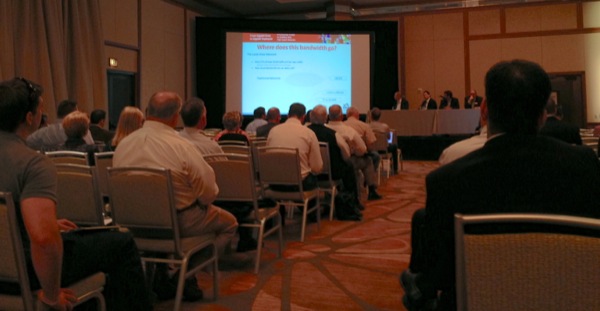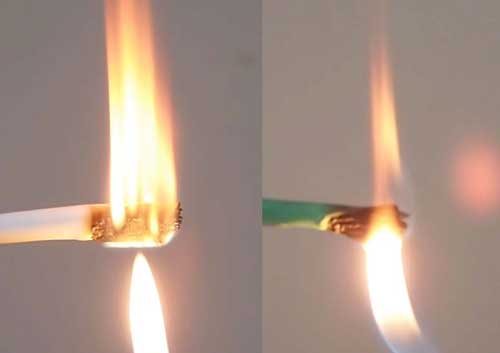The Newsletter of The Fiber Optic Association (original) (raw)
The Worst Aerial Cables In the US? The World?
On a recent trip to New England, we saw a utility pole that was downed during Hurricane Sandy and repaired, we assume in a hurry. The pole was in a residential neighborhood west of Boston. Take a look at this pole:
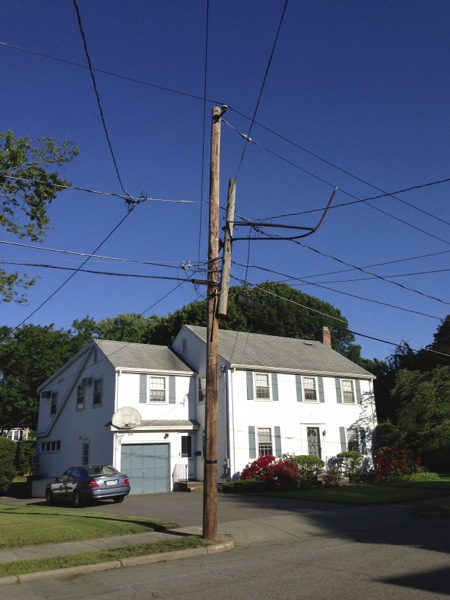
Here is a close up. I don't ever remember seeing a pole like this. Note the mount for a street light curving up from the pole and the tangled cables too. We have no idea if the electrical utility, phone company or CATV provider is responsible.
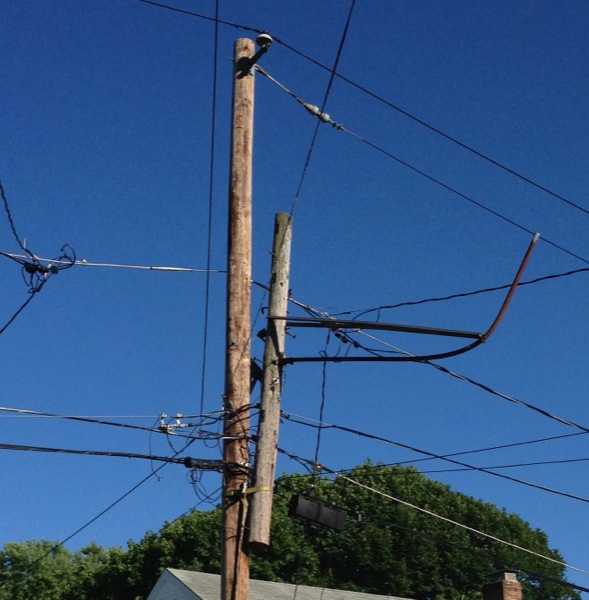
Guess what: this is a FiOS neighborhood! Here is an ONT on the house across the street from that same pole.
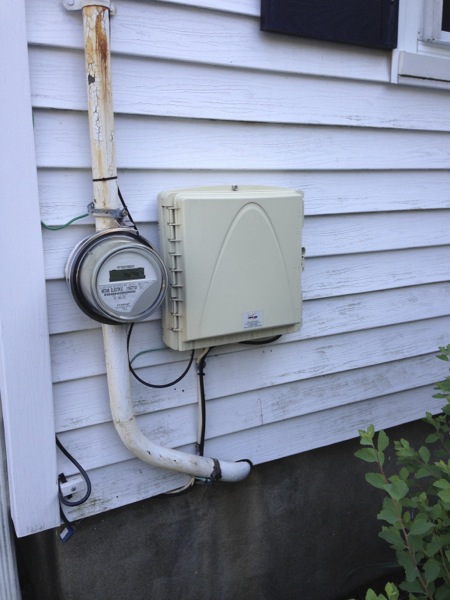
Now, granted that New England has some of the oldest electrical and phone wires in the world (fiber too!) When we lived there, we used to joke that we still used some of the wires installed by Alexander Graham Bell who invented the telephone there. We had a house built in 1938 that was still connected over the original wires installed when the house was new, 60 years earlier. And putting cables underground is expensive. But seeing this pole made us look up as we drove around the area. Here's some more photos of what we saw.
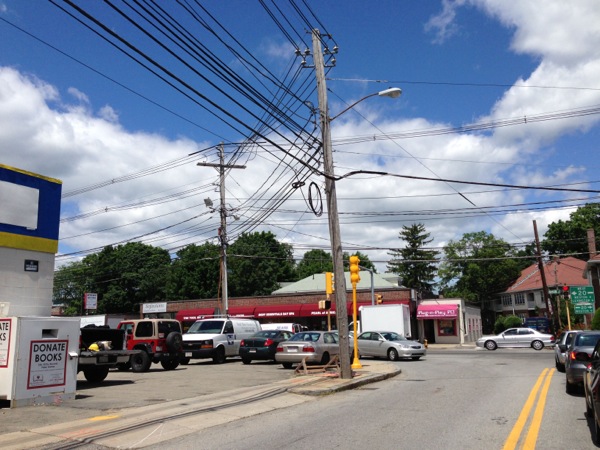

Just imagine a major ice storm in the winter. Or another hurricane.
How about a contest?
Send us your photos of the worst cables you've seen and we'll give a prize to the best photo - a set of FOA books.
Lennie & Uncle Ted Now Available As Free Books on iTunes
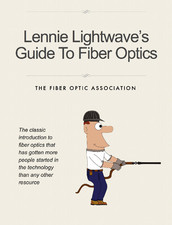
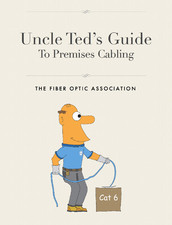
Lennie Lightwave's Guide to Fiber Optics and Uncle Ted's Guide To Premises Cabling are now available free to iPad users who can download them from the Apple iTunes store.
Lennie's Guide has always been the world's favorite introduction to fiber optics. It was first published in the mid-1990s by Fotec, the fiber optic test equipment company famous for its "Fiber U" training conferences and more than 60,000 printed copies were distributed. Lennie was one of the earliest commercial webpages and is still online today (and as popular as ever) at http://lennielightwave.com. Uncle Ted's Guide was created at the request of Lennie readers who wanted a similar simple introduction to "Cat 5" wiring. This latest version of Uncle Ted's Guide covers the all premises cabling topics - wiring, fiber and wireless.
You can find these free guides on Apple's iTunes Store: Lennie Lightwave's Guide to Fiber Optics and Uncle Ted's Guide To Premises Cabling
Salaries For Certified Techs - California Community Colleges Survey
The value of an education has always been a topic of discussion - and controversy. Here in the US, there has been a lot of discussion over the tactics of "for profit universities" and student loans, centered around will a graduate be able to pay back student loans. A brief web search found similar concern in other countries too. Recently a survey of payback for a college degree provided some sobering numbers. For high paying jobs like marketing, there was a ~6 year payback. Medical degrees were ~10 years and for journalism, almost 32 years!
Not everyone wants or needs a college degree. In many professions, an associates degree from a community or technical college and appropriate certifications can provide lucrative employment. What's needed is some data on earnings.
The Chancellors Office of the California Community Colleges is making available for the first time comparative information about the earnings of recent graduates who received an award in a specific program area at California community colleges.
The Salary Surfer uses the aggregated earnings of graduates from a five year period to provide an estimate on the potential wages to be earned two years and five years after receiving a certificate or degree in certain disciplines. This tool also provides information on which colleges offer programs in those specific disciplines. While it is useful to know the potential earnings after receiving a certificate or degree, other important considerations, such as personal interest and skill, should be used in selecting an educational program.
Using the The Salary Surfer website: Use the drop down menus to look at
- Engineering and Industrial Technology > Telecommunications Technology (look at some of the electrical jobs too - certificates sometimes pay higher than degrees!)
- Communications > Technical Communications
- Computer and Information Science > Computer Infrastructure and Support
George Soros Invests £50m into UK FTTH Start-up Hyperoptic
George Soros' private equity fund Quantum Strategic Partners has put £50m into Hyperoptic, a FTTH start-up aiming to leapfrog Britain’s telecoms giants by building a fibre optic network that offers consumers internet access at least 10 times faster than currently available from British Telecom and Virgin Media. Hyperoptic co-founder Boris Ivanovic said “It is not a question of whether people will need one gigabit per second but when.”
What's Google Up To Now?

Having shamed some US providers into saying they will offer Gb FTTH too by building Gb FTTH networks in KC and planning to do the same in Austin and Provo, Google is certainly having an impact on the broadband market. Now they are saying they will bring wireless networks to sub-Saharan Africa. Even the technology is unique - using balloons or blimps to fly antennas instead of towers.
To reach its goal, Google, which benefits the more people have access to its search and other Internet services, is lobbying regulators to use airwaves reserved for television broadcasts (what we call "white space" here in the US and a topic which received much interest in the FOA seminars on fiber we gave in Africa and the Middle East recently), which at lower frequencies can pass through buildings and over longer distances, the WSJ reported.
It is also working on providing low-cost cellphones and employing balloons or blimps to transmit signals over hundreds of square miles from high altitudes.
The company has already begun several small-scale trials, including in Cape Town, South Africa, where it is using a base station in conjunction with wireless access boxes to broadcast signals over several miles, the newspaper reported. Reuters
The Google balloon idea is already being tested in New Zealand, where the photo above was taken. It uses a small antenna shown below.

The idea does sound crazy, even for Google—so much so that the company has dubbed it Project Loon. But if all works according to the company’s grand vision, hundreds, even thousands, of high-pressure balloons circling the earth could provide Internet to a significant chunk of the world’s 5 billion unconnected souls, enriching their lives with vital news, precious educational materials, lifesaving health information, and images of grumpy cats. More including a video explaining the idea on NBR NZ.
Have You Noticed The "Halo Effect"?
We've written before about "bend-insensitive" fibers that use an optical ring around the core to prevent light loss when the fiber is stressed. But when inspecting connectors on BI fiber, you may have seen a "halo" around the core like this.
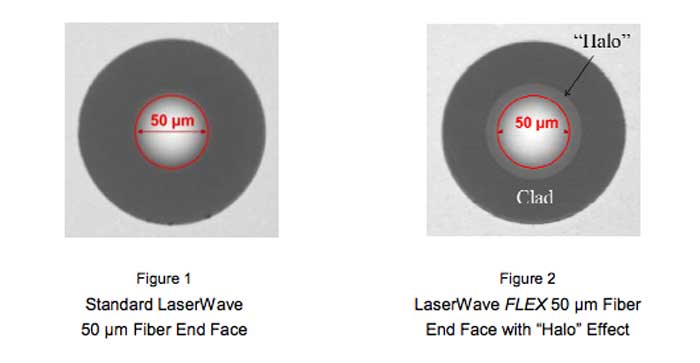
OFS has created an application note that discusses this effect, caused by light in the fiber or from the inspecting microscope. It seems some installers have gotten confused, thinking they are looking at the whole core of the fiber (62.5/125 fiber perhaps) instead of the 50 micron core and the halo caused by the optical "trench" around the core that provides the bend insensitivity.
OFS Application Note On The Halo Effect.
European Project To Design New Fiber Optic Connectors
A EU project aims to develop a new field-installable fiber-optic connector with performance comparable to factory connectorized cables. The aim is to speed up the roll out of fibre-to-the-home (FTTH) networks across Europe. Going under the acronym “Versatile Easy installable Connector implementing new Technologies for accelerated fibre-optic network Roll-outs in Europe”, or VECTOR, the program involves seven industry partners.
TE Connectivity is coordinating the three-year program through its Belgian subsidiary, Tyco Electronics Raychem BVBA. Other VECTOR team members include Demcon Advanced Mechatronics BV (The Netherlands), Celoplás – Plásticos para a Indústria SA (Portugal), Vrije Universiteit Brussel (Belgium), Universiteit Gent (Belgium), Telecom Italia SpA (Italy) and Telekom Deutschland GmbH (Germany).
The system under development will include both a fiber-optic connector and an automated installation tool. The VECTOR Connector will be designed to support insertion and return losses in accordance with international standards – better performance than connectors based on ferrules and aligned in a split-sleeve adapter. The connector will also have a unique self-cleaning feature to improve reliability.
The VECTOR Installation Tool will be a handheld device that will perform fiber connectorization. The installation tool will make installation simpler by automating such functions as fiber stripping, cleaning, cleaving, and alignment.
The VECTOR system will be compatible with the majority of fibre-optic cables, pigtails, and drop cables, according to the project.
FTTH Council Visits Google Fiber Hometown With Agenda To Help Other Towns
The FTTH Council US held its first "Community Toolkit" conference in Kansas City recently. Besides getting an opportunity to visit Google Fiber's customer demo/sales offices and see the advantages of Gb FTTH themselves, they were able to attend numerous sessions to prepare them to initiate and build their own ultra-high speed broadband networks.
Attendees heard from those on the frontlines of the gigabit revolution—public and private sector leaders who have brought (or are bringing) ultra-high speed broadband to their communities like Google and Gig-U. Sessions and workshops covered the tools communities need to get gigabit deployed, including an understanding of the value proposition of gigabit networks and issues of implementation.
The FTTH Council US plans on having more of these meetings, including one in Austin, where Google Fiber's announcement led to AT&T immediately countering with a similar promise.
Watch the FTTH Council Website and sign up for their email newsletters to find out when and where the next Community Toolkit Conference will be held. You can also use their online resources:
FTTH Council Launches Online Resource to Support Quest for Gigabit Service. Community and business leaders looking to secure their economic future through ultra high-speed Internet connectivity now have a convenient online resource to assist them in upgrading local networks to all-fiber, as the Fiber to the Home (FTTH) Council Americas recently launched its Online Community Toolkit. The Toolkit offers an array of templates, white papers, case studies and other features that are designed to assist civic leaders, local telecommunications providers and other groups finance, plan and build all-fiber networks that are capable of delivering gigabit speeds and beyond.
Read more
Community Broadband Networks
A new website has been created to help cities and towns build their own broadband networks. Here's how they describe themselves:
"More and more community leaders pursue local control of connectivity through public ownership, cooperative models, and other nonprofit approaches. At MuniNetworks.org, we provide resources for those joining the movement to build broadband networks that are directly accountable to the communities they serve. Case studies, fact sheets, and video are some of the media we offer to help leaders make decisions about community owned networks.
We strive to offer resources for informed decisions because we know each community is unique. Telecommunications infrastructure is essential to the health and vitality of a community. Networks must be accountable first to the needs of the community, not the short-term interests of shareholders."
Having problems with your Netflix?
The reason may be political. Some broadband providers are not happy with the rapidly growing video traffic, led by Netflix, which is not the largest user of Internet bandwidth. There are subtle ways to influence traffic. Read more about one problem discovered by the Washington Post.
OLANs - Optical LANs - CI&M Webinar Now Available Online
FOA, working with Cabling Installation and Maintenance magazine, presented our third webinar for them- this time on OLANs. The webinar covered the history of cabling for LANs and look at the evolution of cabling for today's high speed networks. More on the webinar at http://www.cablinginstall.com/webcasts/2013/03/passive-optical-lans.html Register to view it at http://video.webcasts.com/events/pmny001/viewer/index.jsp?eventid=45518&adid=ws
OLANs - Resources
Over the last couple of years, we've written a lot about all-optical LANs, either based on FTTH passive optical network (PON) or point-to-point (P2P) Ethernet architecture. The more we see of these types of networks, the more we appreciate their design and economy. But how about scale - how big can they get?
In November, we ran a picture story about the new San Diego Central Library which is using a Tellabs optical LAN using PON technology that was using about 1000 4 port drops. Now we hear another Tellabs customer has over 16,000 users. That must make it one of the biggest LANs in the world.
Here are more sources of information on optical LANs - BTW, they need a name - let's start calling them OLANs!
FOA Guide Page on OLANs and FOA YouTube Video
Tellabs
Motorola
Cliff Walker's FTTO paper
3M on POLs
And the new FOA Lecture 30, OLANs, Optical LANs
New FOA Lectures
WDM: Wavelength Division Multiplexing
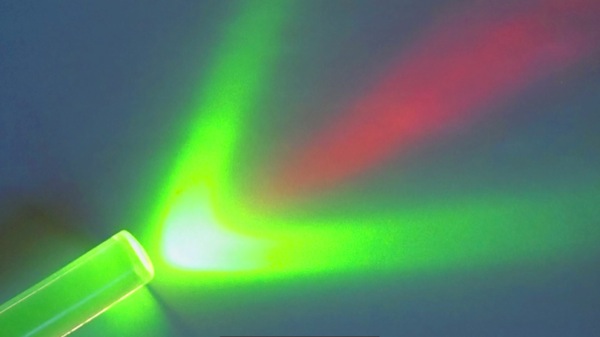
We've added new lecture on Wavelength Division Multiplexing, joining other new topics like the characterization of optical fibers for CD, PMD and spectral attenuation, important issues for long haul systems and DWDM, POF and OLANs..
Lectures On Instructor Training
A new section of the FOA YouTube channel is all about teaching fiber optics and premises cabling. It's designed to help instructors working toward FOA CFOS/I instructor certification but is also useful to anyone teaching fiber or premises cabling.
More On The OTDR
JDSU May Have The Right Idea On Autotest
Autotest for OTDRs is all too often behind the problem when people call FOA for advice on testing. Operators who know little about OTDRs are trained to turn the unit on and hit the autotest button. More often than not, the measurement is all wrong. But JDSU may have the right idea - autotest by application. They are introducing OTDR software just for the wireless FTTA (fiber to the antenna) application. Within the limits of the applications, the OTDR should be able to set up and take data properly. Has anybody tried it yet? Here is the JDSU announcement.
Quick Start Guide For OTDRs
We added to our Online Guide is a new "Quickstart Guide" on using OTDRs which we hope will help users operate them properly:
Quickstart Guide: Testing Fiber Optic Cable Plants With An OTDR
Calibration Of OTDRs
This was posted in response to a recent LinkedIn discussion on OTDR calibration:
Calibration of OTDRs is a messy issue. There are many variables. You can purchase OTDR calibration artifacts for calibrating your OTDR but as far as I know, they are generally not traceable to national standards labs.
Using fibers to calibrate an OTDR introduces errors. Let me elaborate.
Two parameters of the OTDR need calibration: dB and length.
Calibration of the dB scale, used for measuring loss and attenuation coefficient (which is also dependent on length calibration) is complicated by the way the instrument is used. For loss, the measurement is very low in magnitude (~0.1dB) but fine in resolution (as low as 0.001dB), so nonlinearities on a small scale along the entire measurement range are the issue. Proper calibration would include the linearity of the entire measurement range which is virtually unknown.
For attenuation coefficient, the dB measurement is over a longer range and can be done with a calibrated artifact. But that calibration is wavelength dependent.
For length, it's a matter of time measurement in the OTDR - distance is calibrated from the index of refraction of the fiber or the group velocity of the test pulse in the fiber. This can be done with a calibration artifact - a fiber of known length and index of refraction - but again the calibration is wavelength sensitive.
You can get calibration artifacts from NPL in the UK, but you need to know the calibration wavelength of your OTDR and the characteristics of their artifact to make corrections.
Another method uses a electronic calibrator - take the pulse from the OTDR and trigger a delayed return pulse to calibrate the distance scale and a optical ramp to simulate the attenuation of a fiber. This removes the unknowns associated with using a fiber and has been championed by many scientific types.
Any OTDR manufacturers want to offer their wisdom?
Three Good Practice Tools For OTDRs, All Free
FOA OTDR Simulator
You may already know that the FOA has a free OTDR Simulator you can download from our website (go here for directions) that allows you to practice using an OTDR on your PC, seeing the effects of changing setup parameters and analyzing dozens of real world traces. But here are two more tools that can be good for practice.
AFS OTDR Online Demo
AFS has an online interactive demo of their new OTDR that allows you to see how an OTDR makes measurements. You use the yellow buttons in the center of the OTDR to set the markers to make measurements. Very well done. Go to http://www.afsi.us/otdr/otdr_mode.php for the demo.
Fiberizer OTDR App Available Free as "Cloud Service"

Fiberizer Cloud – fiber optic testing data management solution in the cloud. A version of the Fiberizer app for iOS devices.
OptiXsoft and Agizer are glad to introduce Fiberizer Cloud for fiber optic data management and analysis. On the one hand being tiny companies OptiXsoft and Agizer have solid experience in fiber optic test equipment and software development and now offer the Fiberizer App for iPhones and iPads.
The new web service Fiberizer Cloud was developed from the view point of ordinary fiber optic engineers and their businesses. Now engineers have no need to store multiple copies of their OTDR traces on different PCs in tremendous number of nested folders; or to order expensive custom software. Fiberizer Cloud allows to store and analyze fiber optic testing data directly from the browser opened on desktop PC or notebook (iOS and Android mobile clients are coming soon too) connected to the internet wherever they are.
Currently Fiberizer Cloud registration is free and available here: http://fiberizer.com
YouTube video on Fibrizer: (http://www.youtube.com/watch?v=JRiTVDSEaug)
"Fiberizer" APP Reads, Analyzes OTDR Traces
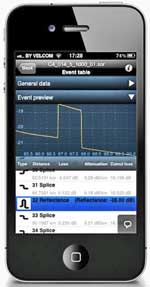
Fiberizer is a iPhone/iPad APP that reads industry-standard ".sor" format files and allows trace analysis on your iPhone or iPad. An android version is in the works too. Read more about Fiberizer. And here are more directions on its use.
OTDR FAQs
Including FOA Master Instructor Terry O'Malley's tests on what the end of a fiber trace looks like with broken and cleaved fibers.
Frequently Asked Questions On OTDRS And Hints On Their Use
Events of Interest

OLANs - Optical LANs - CI&M Webinar- Now Available Online
FOA, working with Cabling Installation and Maintenance magazine, presented our third webinar for them- this time on OLANs. The webinar covered the history of cabling for LANs and look at the evolution of cabling for today's high speed networks.
More on the webinar at http://www.cablinginstall.com/webcasts/2013/03/passive-optical-lans.html
Register to view it at http://video.webcasts.com/events/pmny001/viewer/index.jsp?eventid=45518&adid=ws
FOA presented a special webinar with Cabling Installation and Maintenance Magazine on "5 Ways To Test Installed Fiber Optic Cabling."
This webcast seminar, produced by Cabling Installation & Maintenance and presented by FOA President Jim Hayes, takes a hands-on look at each of these five standard test methods. Attendees will see the physical setup of each method and gain a thorough understanding of each method’s application as well as measurement uncertainty.
You can watch this seminar on your PC or Apple iPad or iPhone.
The seminar is archived on the Cabling Installation & Maintenance Website
FOA Presented a Webinar on Cabling Project Planning And Installation For CI&M Magazine
Topic: Cabling Project Planning - The Customer's Point of View
This webcast seminar was presented by FOA President Jim Hayes. In the seminar, Hayes will explain what is involved in a cabling-installation project (fiber, copper and/or wireless), from concept to acceptance. He will describe the step-by-step procedures, referencing which responsibilities fall on the end user, which fall on the contractor, and the critical points of cooperation between the two.
You can watch this seminar on your PC or Apple iPad or iPhone.
The seminar is archived on the Cabling Installation & Maintenance Website.
Free Corning "See the Light" Seminars
Corning Cable Systems' See the Light team is coming to a city near you! Receive Free fiber optic training on a variety of topics including Termination Technology, Testing and Trouble Shooting, Fusion Splicing, and Preterminated Solutions. These interactive three-hour sessions provide students with a comprehensive overview of the latest technology. Fiber optic BICSI (CEC) credits apply (3). Here is the current information and schedule.

You are invited to join JDSU for a complimentary series of educational webinars. Each webinar, presented by a JDSU subject matter expert, lasts approximately one hour, including Q&A. Seminars are on Connectivity (May 23), Testing Fundamentals (June 20) and OTDRs (July 11)
Go here to see the seminars offered.
Don't forget to download your copies of the JDSU Testing Textbooks.
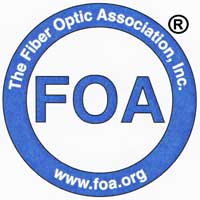 What's Happening @ FOA
What's Happening @ FOA
FOA Certifications Recognized By US Department of Labor
All FOA Certifications have now been recognized by the US Department of Labor. The DoL reviews certifications and how they relate to job opportunities and training. The DoL Career OneStop website helps individuals explore career opportunities to make informed employment and education choices. The Web site features user-friendly occupation and industry information, salary data, career videos, education resources, self-assessment tools, career exploration assistance, and other resources that support talent development in today's fast-paced global marketplace.
FOA Certifications Listed By US Department of Labor - Career OneStop
US Department of Labor Recognizes FOA In New "Occupational Outlook Handbook"
FOA is listed in the new US Department of Labor "Occupational Outlook Handbook" in the section "How to Become a Line Installer or Repairer."
This website lists all sorts of interesting information, including what these workers do in their jobs, how they get trained and certified (where the FOA is referenced) and something everybody is interested in - sections on "Pay" and "Job Outlook" - see the red arrow above.
FOA LinkedIn Group On Fiber Optic Training

FOA has started a new LinkedIn group called "Fiber Optic Training" dedicated to discussions on fiber optic training. Anyone can join our new Linked In fiber optic training group. We're experimenting on teaching instructor-led online courses on LinkedIn - watch for announcements on the FOA LinkedIn group and Fiber Optic Training Group. Take a look and join the group.
 Corporate Memberships
Corporate Memberships
FOA is now offering corporate memberships to companies involved in fiber optics as manufacturers, contractors, installers, etc. Among other benefits, Corporate Membership gives companies access to special FOA materials for educating customers and employees. Read more.
FOA Standards:
FOA has joined the American National Standards Institute (ANSI) to be able to keep up to date on more standards activities.
FOA now offers free standards for testing the installed fiber optic cable plant, patchcords and cable, optical power from transmitters or at receivers and OTDR testing. Look for the "1 PageStandard" web page and in the FOA Online Reference Guide.
View the FOA YouTube Video On FOA Standards
Go to the FOA "1 Page Standards"
Free For FOA Members: NECA/FOA 301 Fiber Optic Installation Standard
Because of its importance to users, contractors and installers of fiber optic networks, The FOA and NECA have agreed to make the NECA/FOA 301 Fiber Optic Installation Standard available free to FOA members. It's specifically written to be used in contracts to define "installation in a neat and workmanlike manner." FOA members can go here for instructions on how to download your free copy.
FOA is a member of:


Free Fiber U Self-Study Programs
FOA'S "Fiber U" free online self-study programs help you learn about fiber optics, study for FOA certifications or use them to help create "blended learning" classes. There are two new free online self-study programs on Fiber U. Fiber Optic Network Design is for those interested in learning more about how to design fiber optic networks or studying for the CFOS/D certification. FTTx is for those wanting to know more about fiber to the "x" - curb, home, wireless, etc. - or studying for the CFOS/H certification.
Got to Fiber U for more information.
Lennie & Uncle Ted Now Available As Free Books on iTunes


Lennie Lightwave's Guide to Fiber Optics and Uncle Ted's Guide To Premises Cabling are now available free to iPad users who can download them from the Apple iTunes store.
Lennie's Guide has always been the world's favorite introduction to fiber optics. It was first published in the mid-1990s by Fotec, the fiber optic test equipment company famous for its "Fiber U" training conferences and more than 60,000 printed copies were distributed. Lennie was one of the earliest commercial webpages and is still online today (and as popular as ever) at http://lennielightwave.com. Uncle Ted's Guide was created at the request of Lennie readers who wanted a similar simple introduction to "Cat 5" wiring. This latest version of Uncle Ted's Guide covers the all premises cabling topics - wiring, fiber and wireless.
You can find these free guides on Apple's iTunes Store: Lennie Lightwave's Guide to Fiber Optics and Uncle Ted's Guide To Premises Cabling
Reference Books for FOA Certifications available on Kindle and iPad/iPhone
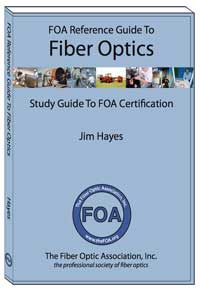
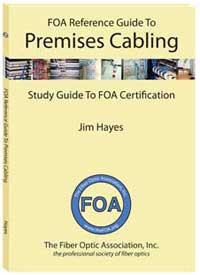
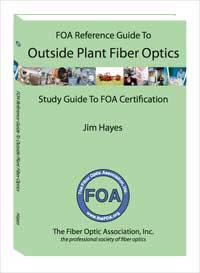
We have created three new FOA books to be used in training for FOA certifications and as reference books for contractors, installers and end users of fiber optics. These books have full curriculum support, including free curriculum materials for teaching FOA certification courses. Because we are self-publishing these books using more modern "publish on demand" technology, they are easier to keep up to date, easier to buy and much, MUCH cheaper!
All are now available in print and electronically in Kindle and Apple iBook versions. The basic fiber optic book is also available as a self-study program in an Apple APP for iPad/iPhone/iPod.
Details on the new book each of the new books are at the book pages linked to the photos above.
FOA iPad Apps
The FOA has just released its second APP for the iPad, a free "loss budget calculator," FOA LossCalc.
FOA LossCalc
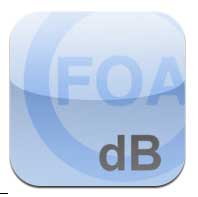 FOA LossCalc estimates the optical loss of a fiber optic link. This will save time for the installer of a fiber optic link needing to know whether test results are reasonable and/or make a "pass/fail" determination. It can also help the designer of a link to determine if communications equipment will operate over this link.
FOA LossCalc estimates the optical loss of a fiber optic link. This will save time for the installer of a fiber optic link needing to know whether test results are reasonable and/or make a "pass/fail" determination. It can also help the designer of a link to determine if communications equipment will operate over this link.
By choosing the type of link (singlemode or multimode) and specifying the length of the fiber and numbers of connections and splices, it will calculate the end to end loss of the link. The app has default specifications for singlemode and multimode links or the user may create custom setups with specifications appropriate for any application. http://itunes.apple.com/us/app/foa-losscalc/id476262894?mt=8&ls=1
Self -Study in Fiber Optics
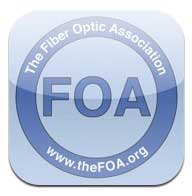 Our first app is a self-study version of the FOA Reference Guide to Fiber Optics. The FOA APP builds on the FOA basic fiber optic textbook to create an interactive learning environment that builds on the iBook electronic version of the book to add a guide to use for self-study and real-time testing that provides feedback on what you have learned and correct answers to questions answered incorrectly.
Our first app is a self-study version of the FOA Reference Guide to Fiber Optics. The FOA APP builds on the FOA basic fiber optic textbook to create an interactive learning environment that builds on the iBook electronic version of the book to add a guide to use for self-study and real-time testing that provides feedback on what you have learned and correct answers to questions answered incorrectly.
The FOA APP is priced at only $9.99, same as the iBook, so the self-study program is free. Download it from the Apple APP Store with your iPad or iTunes.
http://itunes.apple.com/us/app/foa-guide/id434354283?mt=8&ign-mpt=uo%3D4
NECA/FOA 301 Installation Updated
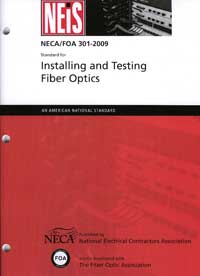
Standards cover components and systems and how to test them, but rarely get into installation issues. The FOA NECA 301 standard which covers installation of optical fiber systems has been revised for the second time, adding considerable new materials. This standard is derived from FOA educational material put in standards form and approved by ANSI as an American National Standard. It's specifically written to be used in contracts to define "installation in a neat and workmanlike manner." The standard is available from NECA. FOA members can go here for instructions on how to download your free copy.
More "Quickstart Guides"
In our continuing quest to help people understand how to test fiber optic cable plants and communications systems, we've created two more "QuickStart Guides to Fiber Optic Testing." They are simple, step-by-step guides on how to test fiber optic cable plants, patchcords or single cables using insertion loss or OTDR techniques and optical power from transceivers. It's as straightforward as it can get - what equipment do you need, what are the procedures for testing, options in implementing the test, measurement errors and documenting the results.
It can't get much simpler.
Send anybody you know who needs to know about fiber optic testing here to learn how it's done in a few minutes.
Testing Fiber Optic Cable Plants And Patchcords
Testing Fiber Optic Cable Plants With An OTDR
Measuring Optical Power In Communications Systems
The FOA has many videos on YouTube, including two Lecture Series (Fiber Optics and Premises Cabling), Hands-On lectures on both and some other informational and instructional videos. For all the videos, go to the FOA Channel "thefoainc" or use the direct links below.
New FOA Lectures
We've added new lecture on Wavelength Division Multiplexing, joining other new topics like the characterization of optical fibers for CD, PMD and spectral attenuation, important issues for long haul systems and DWDM, POF and OLANs..
FOA Lecture 28, Fiber Characterization
FOA Lecture 29, Plastic Optical Fiber (POF)
FOA Lecture 30, OLANs, Optical LANs
FOA Lecture 31, Wavelength Division Multiplexing
We also added a Premises Cabling lecture on counterfeit Cat 5 cable, with a demonstration of its flammability.
Premises Cabling Lecture 11: Counterfeit Cat 5 Cabling
Hazards Of Counterfeit Cable
You may have read the stories we have written about the counterfeit "Cat 5" cable made from copper-clad aluminum rather than pure copper. Recently we tried an unscientific burn test on the cable compared to a known good UL tested cable and posted a video on YouTube. You can see the results below.
Counterfeit Cable Real UL-rated cable
The difference is obvious and the danger is real. Watch the video on YouTube: Premises Cabling Lecture 11: Counterfeit Cat 5 Cabling
2 New "Hands-On Hints" Videos:
Using an OTDR
Visual Inspection of Connectors With A Microscope
Below is a list of all the current lectures (plus there are 28 hands-on videos too!). We're looking for ideas for topics for future lectures. Send your ideas to info@thefoa.org.
Hands-On Fiber Optic Videos show how it's actually done
Using an OTDR
Visual Inspection of Connectors With A Microscope
Fiber Optic Connector Polishing Technique
Prepolished Splice Connector Termination (Unicam)
The Fiber Optic Tester In Your Pocket (Cell Phone)
Insertion Loss Testing
Fusion Splicing
Mechanical Splicing
Fiber Optic Termination, Part 1, Setup & Tools
Fiber Optic Termination, Part 2, Jacketed Cable Prep
Fiber Optic Termination, Part 3, Adhesive Prep
Fiber Optic Termination, Part 4, Stripping Fiber
Fiber Optic Termination, Part 5, Connector Attachment
Fiber Optic Termination, Part 6, Polishing
Fiber Optic Termination, Part 7, Inspection
Fiber Optic Termination, Part 8, Distribution Cable Termination
Fiber Optic Cable, Part 1 Introduction
Fiber Optic Cable, Part 2, Zipcord
Fiber Optic Cable, Part 3 Distribution Cable
Fiber Optic Cable, Part 4 Breakout Cable
Fiber Optic Cable, Part 5 Loose Tube Cable
Fiber Optic Cable, Part 6, Armored Cable
Lectures On Premises Cabling
The FOA has added more videos to our YouTube Channel, thefoainc. These are an introduction to premises cabling, covering applications, types of cabling, standards and installation practices for copper (UTP and coax), fiber and wireless. Like our lecture series on fiber optics, these provide a comprehensive introduction to the subject in short videos, typically 5-10 minutes in length, on each subject. Watch for more.
Premises Cabling Lectures on YouTube
"Hands-On" UTP Cabling Videos show how it's actually done
UTP "Cat 5" Cabling, Part 1, Tools
UTP "Cat 5" Cabling, Part 2, The Training Board
UTP "Cat 5" Cabling, Part 3, UTP Cable
UTP "Cat 5" Cabling, Part 4, 66 Block Punchdown
UTP "Cat 5" Cabling, Part 5, 110 Block Punchdown
UTP "Cat 5" Cabling, Part 6, Jacks
UTP "Cat 5" Cabling, Part 7, Testing
UTP "Cat 5" Cabling, Part 8, Plugs and Patchcords
Lectures On Instructor Training
A new section of the FOA YouTube channel is all about teaching fiber optics and premises cabling. It's designed to help instructors working toward FOA CFOS/I instructor certification but is also useful to anyone teaching fiber or premises cabling.
FOA Instructor Training and Certification Playlist (all videos)
FOA Instructor Training - Part 1 -Introduction
FOA Instructor Training - Part 2 - About The FOA
FOA Instructor Training - Part 3 - FOA Approved Schools
FOA Instructor Training - Part 4 - Instructors
FOA Instructor Training - Part 5 - Curriculum
FOA Instructor Training - Part 6 - Teaching A Course
FOA Instructor Training - Part 7 - Hands-On Labs
FOA Instructor Training - Part 8 - FOA Resources
View all the FOA YouTube video Lectures.
What's New in the FOA Online Fiber Optic Reference Guide
We have been updating the Online Reference Guide to keep up with changes in the industry and adding lots of new pages of technical information.
What's A Network? A simple explanation of network types and operation has been added to the FOA Online Guide.
FOA has added a page on Connector Repair to our Online Guide.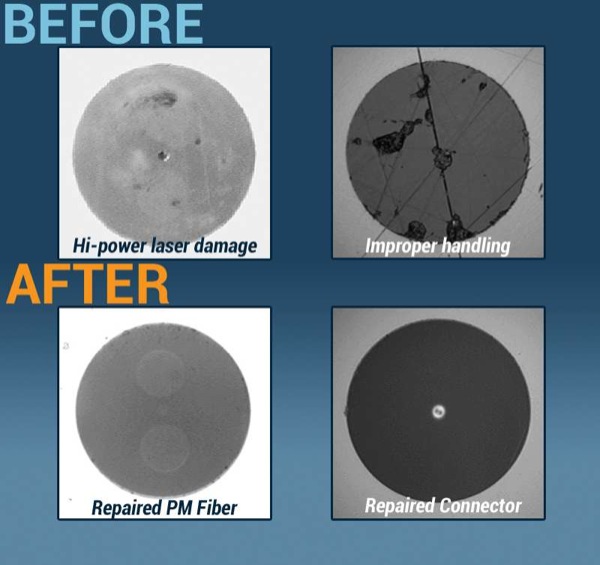
FTTH in MDUs (Multiple Dwelling Units)
When we talk about FTTH, we often assume we are installing the fiber to a “home” where it terminates in a optical line terminal (OLT) and services (voice, data and video) are delivered inside the subscriber’s "home." But since we may have detached single-family homes, row houses or living units in a large building, the situations can be quite different, requiring different architectures and installation practices. To clarify the options for fiber in MDUs, FOA has created a new page in our FTTx section of the FOA Guide to explain the options.
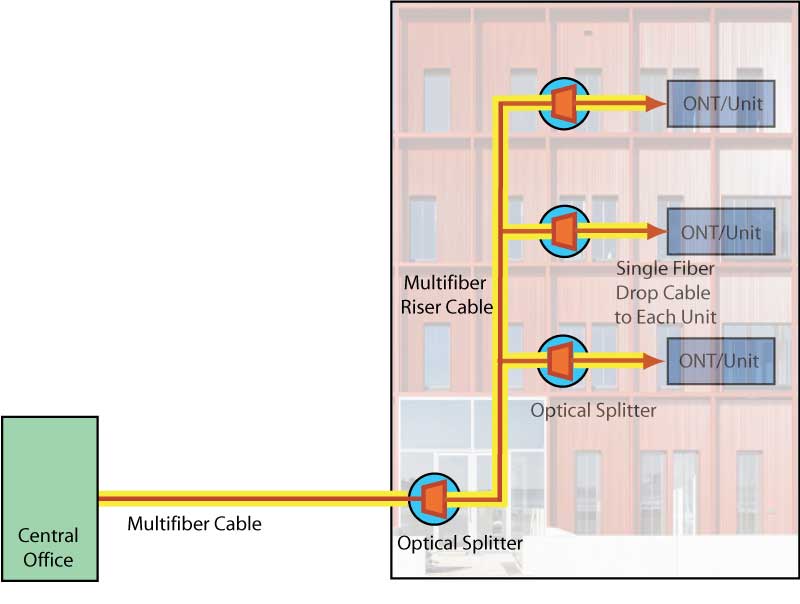
FOA Guide: FTTH in MDUs
Three new "Quickstart Guides" for fiber optic testing: cable plant & patchcord loss, power and OTDR
OLANs: Optical LANs - based on FTTH technology and offering speed and economy for most premises applications.
FTTx and Design Pages Updated
As we developed the new Fiber U self-study courses, we updated the FTTx and Design pages and added a FTTx installation section.
Testing FTTH
Basic guidelines for testing FTTH PON networks
Learn More About OTDRs - Download a Free OTDR Simulator
More and more installers are being asked for OTDR testing but using these instruments is not easy. They are hard to set up properly and complicated to interpret the traces. Using the autotest function can lead to disastrous results! The FOA has a good tutorial on OTDRs on our Online Reference Guide and we added a free download of an OTDR simulator to the OTDR section so you can learn how to use an OTDR on your PC.
More New Info:
Links to manufacturers and distributors of fiber optic lighting products.
The FOA Online Fiber Optic Reference Guide has become very popular - perhaps the most popular technical website ever, typically with over 360,000 users downloading about 1.75 million pages in 2011! We continue updating materials regularly, keeping it as up to date as possible.
Find What You Want Using "Google Custom Search There's so much information on the FOA Tech Topics and Online Fiber Optic Reference Guide that even a well-organized Table of Contents isn't enough and when the material is always changing, an index is impossible to maintain. So the FOA is using the latest technology in search, Google Custom Search, which will allow you to search just the FOA Tech Topics and Online Fiber Optic Reference Guide for any topic you want to find more about. Try it!
There's so much information on the FOA Tech Topics and Online Fiber Optic Reference Guide that even a well-organized Table of Contents isn't enough and when the material is always changing, an index is impossible to maintain. So the FOA is using the latest technology in search, Google Custom Search, which will allow you to search just the FOA Tech Topics and Online Fiber Optic Reference Guide for any topic you want to find more about. Try it!
Go to The FOA Online Fiber Optic Reference Guide.
RETURN TO INDEX
School News
Quote from one of our certified instructors: I want to thank you and your organization for all the resources you provide for the students and the opportunity to offer the certification to the students. The fact that you published the book yourself to get the cost down and the unlimited free resources on your website shows a commitment to the public that is second to none. I let it be known to the students that the FOA is the best in the industry at supplying knowledge and resources related to the communication industry. I look forward to passing on the information that you provide for the industry.
How Sophisticated Can Training Be?
Ian Gordon Fudge of FiberDK tells us about his OSP course including WDM: "Here is a picture from the training today, we have a 4 channel CWDM system up and running with a two channel DWDM running on the same two fibers. The distance between the two ends is over 20Km, The fibers were tested for CD and PMD and with an OSA for attenuation, In the middle is an OADM, pulling of one of the channels. The system is live and running, this is why we have 6 gigabit switches at each end."

Great Video About An FOA School And Their Training
BDI Datalynk trains at the Unversity of Central Florida. UCF created this incredible video on the BDI Datalynk program. It shows the power of what we offer in our campuses around the US.
Watch the video here: http://www.ce.ucf.edu/Program/2583/Fiber-Optics-Network-Certification-Courses-Non-credit/
For more information, contact Bob Ballard, CFOS/I, BDI DataLynk, LLC, A Vietnam Veteran-Owned Company
www.bdidatalynk.com, Ph: 512-785-9024
New Schools
The FOA welcomes the newest additions to our listing of FOA-Approved Training Organizations:
Fibre Zone in Quebec- # 333
Find a listing of all the FOA-Approved schools here.
It's Now A Lot Easier To Find A FOA-Approved Training Organization
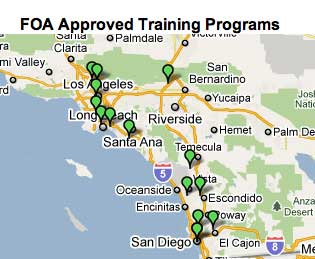
Most phone calls we get regarding finding a FOA-Approved training organization want to know two things: what school is closest to me or what school offers the certifications I need. That can be difficult, since the FOA has almost 200 training organizations we have approved worldwide!
We've been looking at ways to make it easier, and we think we've got a good solution. In fact we have two solutions.
First we have added a sortable table of all the FOA-Approved schools.
You can also use our FOA Google Map Application to find FOA-Approved schools.
Here are links to the sortable table of all the FOA-Approved schools and FOA Google Map.
What Should A Fiber Optics or Cabling Tech Know and What Skills Do They Need?
The FOA has been updating its lists of KSAs (Knowledge, Skills, Abilities) for fiber and cabling techs. The updated list is now on the website for your information and comments - as fiber and cabling KSAs evolve as new technologies develop.
KSAs for fiber and cabling techs.
Good Question! Tech Questions/Comments Worth Repeating
Tech Hint: Did You Know You Have A Fiber Optic Tester In Your Pocket?
Yes! That old mobile phone has a camera which may be sensitive to infrared light - lots more than your eye - and can detect light in an optical fiber or from a transmitter. Chris Hillyer,CFOT/CFOS/I, Master Instructor, Northern California Sound & Communication JATC sent us some photos showing how this works. See below or the video now on YouTube. Update: You should check out your old cell phones before you recycle them. We've found older models use sensors which are better at infrared than the newer ones which take better pictures. This is a good use for your old cell phones hiding in the drawer!
Bend Radius For Fiber? (From a FOA school instructor) (6/13)
Q: I have a question regarding the bend radius that was asked in my class. We understand the bend radius as it pertains to pulling cable. One of my students wanted to know if it still applies to individual fibers after the jacket has been stripped off.
A: Excellent question. The cable rules come from manufacturers who must make cables to handle the stresses of installation. When you get to the fiber level, the situation will depend on the type of fiber and the application, e.g. in splice closures or patch panels and the type of fiber.
When splicing SM fiber cables together, the splice closure is designed to protect the fibers from stresses which can cause loss or long term unreliability. When SM was mostly used at 1310nm wavelength, the closures were designed for about a 3" diameter fiber loop for the 250 micron buffer fiber. With more use at 1550nm where bending losses are more severe, a ~4" diameter loop was adopted. Thus it was the fiber and closure manufacturers who jointly developed a de facto standard.
For tight buffered fiber, mostly MM in premises cables, the issue was how fibers would be routed inside a box with connectors installed on each fiber. Here a minimum radius of ~32 mm was common practice.
All this, of course, predates bend-insensitive fiber. With those, fiber manufacturers seem to be competing to see who can abuse their fiber the most! While BI fibers do not have as much stress loss, the long term reliability of a tightly bent fiber is still questionable so conservative guidelines should be followed. BI fiber is very popular for indoor applications, but should still be handled with care. It has made possible some new ultra-small cables which are easier to install in buildings.
Standards For Datalinks
(6/13)
Q: I have the ITU G.652 standard and the 662 standard as well, but these address more of the fiber and component system requirements, characteristics and performance without any test convention related info. Are there any fiber based system test references/standards you can recommend?
A: Most standards are written for component manufacturers, not system users. Test standards generally refer to the cable plant, not the system. For the cable plant, you do a "loss budget" which estimates the loss and then do an insertion loss test to see how test results compare to the loss budget estimate.
Here is information on the loss budget http://thefoa.org/tech/lossbudg.htm
And information on testing from the FOA standards http://thefoa.org/tech/ref/testing/test/OFSTP-14.html
There are standards for many communications standards, for example Ethernet (see http://thefoa.org/tech/Linkspec.htm) but many systems are proprietary, so the manufacturer specifies the link "power budget" based on the output power of the transmitter and input power requirements of the receiver. See http://thefoa.org/tech/ref/appln/datalink.html
The system manufacturer will specify a cable plant loss budget to be less than the link power budget to leave some margin for system operation over time.
Note: This seems to be a problem that has not been addressed by standards. FOA is considering creating a "datalink" standard to address the need.
Is Reflectance A Problem on Short SM Links? (6/13)
Q. Have you heard of high reflections causing issues with short SM links? If so, at what speeds and levels of reflection? The standards only require -26dB for SM, but does that only work for lower speed applications? TI have noticed with higher speed digital systems that reflection can cause issues.
A: We started hearing about it on campus type applications of Gigabit Ethernet using SM ~1km long - that was a decade ago. The first time it was with field terminated SM (I's bet using MM techniques) that was probably -20dB reflectance. Cutting the field terminations off and splicing pigtails on the cable solved the problem.
We've seen other similar instances, all with short SM links. We believe the problem was not with the commonly accepted explanation, interference with the laser transmitters (which may affect the linearity of analog transmitters), but multiple reflections (like you see with ghosts on an OTDR) adding to receiver noise. Each connection can add to the reflectance. Higher speeds makes it more problematic because the power budgets are lower but the background noise remains fairly constant.
It appears to be a problem also on FTTH and OLAN PONs. Most of these networks are now specifying APC connectors to stop reflections.
Regards,
What Connector Is This? How Do I Test It? (5/13)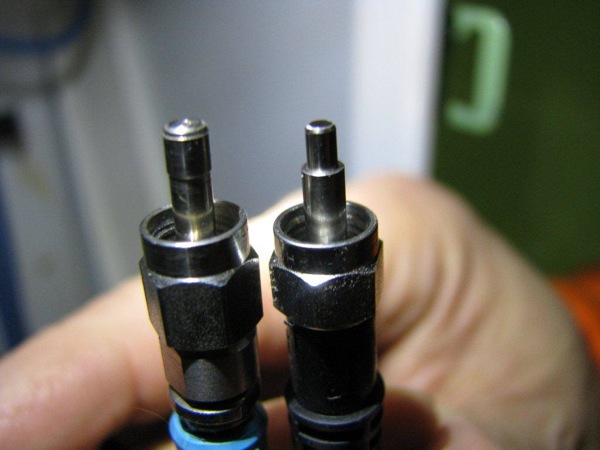
Q: Have you seen this connector on the left side of the picture before? It looks similar to an SMA 905 connector but it has a ridge around the ferrule. I have a customer that wants to be able to test their existing cable that has these connectors. Do you have any ideas on how I can test this cable?
A: The connector on the left is a SMA 905 and the one on the right is a SMA 906. The ridged design was used by some manufacturers to make it easier to machine - only a small part of the ferrule was necessary to grind to the exact 0.125 inch diameter and it reduced friction when inserting it into mating sleeves. Check the diameter with a micrometer and it should be 0.125 inch.
Testing these can be tricky if the fiber is a large core PCS fiber. First, check it with a microscope if you have one with a SMA adapter. Otherwise, try a jewelers loupe and compare it to a 125 micron OD fiber to see if it is indeed larger.
If so, it can be tested with a hybrid patch cord as you describe. The problem may be finding a SC or ST connector that can accommodate the larger fiber. Are the cables that need testing using SMAs on each end? Or just one end? Testing with a power meter with modular adapters that can handle SMAs makes it easy. Use a single-ended test to check connectors on each end.
See http://www.thefoa.org/tech/ref/1pstandards/FOA-2.pdf or http://www.thefoa.org/tech/ref/testing/test/FOTP-171.html Color Codes
(5/13) Q: Is there a publicly available document that defines the twelve TIA/EIA colors for fiber conductors?
A: I did some searching and found this: http://munsell.com/color-blog/color-codingchart-wire-color-coding/
Do Fusion Splicer Machines Measure Splice Loss Accurately? (5/13)
This topic came up on a LinkedIn discussion recently and this response was posted:
"We made a study to determine how an OTDR bidirectional test corresponds to the splicer evaluation (splicing the same fiber type to reduce errors from mismatched fibers). We determined that if we want to have a splice attenuation less than 0,15 dB (OTDR) , we have to keep the splice machine evaluation data under 0,04 - 0,05 dB (Splicer). The statistic on the field shows 1-2 splices abouve 0,15 dB/ 1000 splices (OTDR). So, if the splicer indicates 0,0 - 0,05 dB, we can believe it. The difference by testing with OTDR will be about -0,01 to +0,05dB. But if the splicer indicates 0,1 to 0,2 dB it could be expected 0,1 to 0,3 dB(OTDR)."
Network Vs Connection Speeds (5/13)
Q: In FTTH, how can a splitter connect users who have different connection speeds, like 25, 50 or 100Mb/s?
A: This is confusing to many people, I think. The difference between the physical layer of a network which carries the traffic and the management of the traffic is confusing.
All networks share bandwidth. In fiber, it is done by time-division multiplexing or wavelength-division multiplexing.
The confusion comes with the sharing part. If a GPON system provides 2.5Gb/s to 32 users, each user does not have 2.5Gb/s/32=78.125Mb/s bandwidth available; that approach is too simple-minded. In fact, the 32 users "statistically" share the bandwidth. Because all users are connected at the same speed - 2.5Gb/s and the data is handled in packets as each subscriber uses the network, the use is randomized. If some users is active but others not, which is how it works in the real world, the network utilization is continually changing.
Faster connection speeds reduce the time each subscriber is tying the network up. When you "buy" a connection at 50 or 100Mb/s, you are paying to be "throttled" or limited. In fact, it's smarter from a provider point of view to charge per total bits of usage and provide each user with max bandwidth as it leads to lower latency and better customer service.
Installation Cost (5/13)
Q: What does it cost to install fiber optics?
A: That's a tough question. It depends on the geography - not just what the area looks like but where it is. An installation on a big city will be much more than a rural installation. Burying cable directly is less than installing conduit and pulling cables into it. Aerial cable can be cheaper if the poles are already in place. Underwater costs vary depending on the depth and length. When recently asked this question, we found an interesting US Dept. of Transportation document online that is a database of projects which shows the varieties of costs. Read it here or download as a xls file.
Tracer Wire or Tape? (5/13)
Q: Is it recommended to have locate wire in the conduit with the fiberoptic cable?
A: Outside plant buried cable is usually buried with a locating wire or tape to allow finding the exact location of the cable in the future. If the conduit is plastic, a copper wire inside the conduit will work. Another option is to use special conductive locating tape which is buried above the conduit or direct buried cable (armored cable which can be buried without conduit - sometimes the armor is metallic and can be used for locating it).
Singlemode Fiber Use (5/13)
Q: Can I use any SM fiber at any wavelength?
A: SM fiber comes in several varieties and many can be used at any wavelength between ~1280 and ~1650nm. For example G.655.D fiber, designed for long links at 1550 and DWDM, will NOT support the 1310nm window in the G.652.D fiber ( 28E+ fiber). The cutoff wavelength is approx. 1450nm. SM fiber designed for use at 1310nm will have a cutoff wavelength of ~1260nm.
When To Use An OTDR (4/13)
Q: When should a contractor test with an OTDR? The contract states that they shall follow all TIA best practices. The contractor is aruging that the OLTS is good enough. Is there any test that is an OTDR can do that is a standard that a OLTS not do, like ORL?
A: There are really two issues: Is OTDR testing appropriate and is it going to give useful information?
OTDR testing is useful to verify splice loss on concatenated OSP cables, find events with high reflectance or find faults or points of stress induced during installation.
OTDR testing is not useful on most premises applications because the cables are too short to be resolved, connector loss has high uncertainty unless measurements are made in each direction and averaged, and even the old argument that it finds stress loss points from bad installation is moot since most Fiber used in premises installation is bend-insensitive variety (MM & SM) and it won't show stress loss anyway!
OTDR manufacturers have gotten creative about what OTDRs can do to sell more units, but that doesn't change the reality of what the instrument can do. And the study used to get them approved for "certification testing" was only valid for 10G OM3/4 fiber with less loss than 2 dB-not all installations.
BTW, there is another issue. Cost! OTDR testing is expensive testing - especially if you do not get useful info.
Something else relevant, from the wisdom of a company I worked for in the IC automatic test business.
1. Testing costs $ so never perform a test unless there is a valid reason for it.
2. Never test anything if it always passes - that's a waste of time and $. Same if it always fails - but then you must stop and investigate why it is failing.l
3. Always understand the uncertainty of the measurement so you know the "error bands" and have means to evaluate whether something is good or bad if it falls inside those bands. Failing a good part is as wrong as passing a bad one. This is why experts complain so bitterly about the "pass/fail" testing advocated by some OTDR manufacturers.
How Deep To Bury Cables? (4/13)
Q: I am trying to find either a regulation or guidance document on the minimum depth fiber optic cable should be installed.
A: This is a question we get often - the answer is "depends." Some local ordinances will specify the depth of buried cables, but many cities have no regulations. Generally, cables are buried ~3 feet deep, although in some areas (South Africa, for example), a depth of 1.5m (almost 5') is required since that is lower than most automated trenching machines and will help prevent accidental digups. In cities, it's necessary to work around current infrastructure. In farmland, direct buried cable is sometimes plowed in at ~3'. Microtrenching is becoming popular in cities (see the FOA newsletter for a story about it in Toronto: http://www.thefoa.org/foanl-10-11.html) and that cuts a groove 8-12" below the road surface to bury smaller cables and ducts. Sometimes, with fiber to the home (FTTH), the cable is buried at a lesser depth (12-18") in the customers yard, but we've already heard of these cables being cut by the homeowner!
RUS has a construction document that may be of interest.
Link Distance Calculations (4/13)
Q: We have some optical extender boxes for digital video transmission. I would like to know how to calculate the maximum distances we can achieve using different data rates and different types of multimode fibers. I know the power optical budget we have, its: 8dB. We use CWDM VCSEL lasers. So from this I can calculate the total attenuation adding the insertion loss and fiber loss. This gives a maximum distance. However there’s an other property called the bandwidth of the fiber, [MHz*km] which is different for OM1, OM2, OM3 and OM4 fibers. How do I calculate that?
A: There are two answers to your question - choose the one that gives the most conservative answer!
1. Use the fiber specification for bandwidth to calculate the distance. Since you are using a VCSEL, the chromatic dispersion is low so modal dispersion dominates. There is a table at http://www.thefoa.org/tech/ref/basic/fiber.html in the middle of the page that shows the bandwidth of the various MM fibers (OM1-4). To calculate length, let's say you need 100MHz bandwidth. An OM2 fiber has 500MHz-km bandwidth so it would be limited to ~5km on bandwidth, but of course it would have over 15dB loss, so bandwidth is not an issue if you have 8dB limits.
2. Compare it to other digital networks. http://www.thefoa.org/tech/Linkspec.htm has a list of networks and their allowed link lengths on various fibers. Pick one that is similar in bit rate to your network. So 10/100Base-SX which uses LEDs and suffers both chromatic and modal dispersion, is limited to 300m on any fiber (chromatic dispersion is a big limiting factor on LED systems). But 1000Base-SX uses VCSELs at 850nm and the link length is variable with fiber bandwidth.
Polishing Connectors (4/13)
Q: I now know that a rubber polishing pad produces a PC connector, a glass pad produces an air gap connector and that air gap connectors avoid fibre damage caused by ferule rotation when mating connectors. When fitting ST connectors, am I correct in assuming that they always be polished with a glass pad to produce an air gap finish? And following this logic, SC and LC connectors would always be fitted using a PC finish?
A: ST connectors were one of the first connectors to be keyed so the ferrules would not rotate in mating and therefore could be a contact connection. In fact they were spring loaded to ensure contact. At first they were polished flat but then the soft polish and ferrules molded with a convex end were introduced to produce PC finishes with lower loss and reflectance. So STs, SCs, LCs or any connector with a ceramic ferrule should be polished on a rubber pad - 80 durometer rubber is the spec.
Backwards Fiber Loss (4/13)
Q: I have a question. I have three SM fiber runs between 300 and 550 feet. connectors on both ends, and we are testing with an OTDR with launch reel. I am getting around .03 at 1310, but I am getting .18 to .23 at 1550. Why would i get a higher loss at 1550 then 1310. I feel that it has to do with the distance and wavelength at 1550.
A: Sounds like some stress on the fibers. At 1550, fiber is extremely sensitive to bending/stress losses compared to 1310. Look for tight bends in the cable or even stress at the connectors. Check them with a visual fault locator and look for light in the cable just behind the connector.
Caution: Patching and Unpatching in High Power Equipment (4/13)
An interesting exchange occurred recently on LinkedIn regarding damage to fiber optic connectors used in DWDM systems with fiber amplifiers. It's something not often mentioned but could be an issue in many systems.
Q: We are facing a problem that mainly occurred when we tried to introduce a high power 21dBm EDFA in our network for 64 split in our FTTH network. The problem is that it damages connectors and patch cords very quickly. Is it recommended to swich off the equipment before patching and unpatching? We find it difficult to implement becuase once some ports of the EDFA are used, there are running customers on those ports and we cannot power OFF the equipment again and again. Is there any other solution to safely patch and unpatch ot equipments with such high powers or we have to switch it OFF anyway?
A: I was one of the first in the USA to be trained ( in early 1990s) on EDFA OP-AMPs. You must turn-off the TX (laser/amp) prior to disconnecting the connector. If you do not you will hear a "snap" when disconnecting the connector. This is the laser reflecting back and forth between connector faces. The core of the fiber will melt down burning the core black. ( check with the equipment off and with a microscope) You will see a black tunneled out core. You will have to replace the connector in the equipment as well as the jumper you disconnected. Please use all safety practices here as this can blind a person if you have active equipment while testing!
Tim DeHart
This has always been a problem with high power in fiber networks as the core of the fiber is so small the power density is extremely high. The light out of the fiber is high enough to be harmful to eyes too! Turn the system off before patching!
Using A System Source For Testing Loss (4/13)
Q: Can an SFP optical transceiver be used in place of a light source to test link attenuation?
A: Certainly a system source can be used to test attenuation. You just need a means to turn it on and have it stay on for the duration of the test. Attach a launch cable or patchcord to it, measure the output of that patchcord with a power meter and use as the "0 dB" reference. Connect it to the cable plant, attach a patchcord to the other end and measure the power output - the same output that would be coupled to the receiver. The difference in the two power levels is the loss. In fact, you measure the actual loss the cable plant will see in operation.
The method is similar to this: http://www.thefoa.org/tech/ref/testing/test/OFSTP-14.html
About the only time we would not recommend this is a DWDM system or AM CATV ssytem with a high power laser and/or fiber amplifier as the power levels are high enough to be dangerous, to the connectors as well as the equipment and test personnel!
OTDR Readout (3/13)
Q: If I set my OTDR to measure distance in kilofeet or miles, does the OTDR still display fiber attenuation in dB/km?
A: Yes, it seems most OTDRs will report the fiber attenuation coefficient in dB/km even when you measure distance in other units.
Microtrenching (3/13)
Q: I’m hoping someone can point me in the direction of a technical paper on micro trenching.
A: We've covered the topic many times in our newsletters and online Guide. I used our site's Google Custom Search and found some references:
10/11 - The Fiber Optic Association Newsletter
6/12 - The Fiber Optic Association Newsletter
OSP fiber installation - The FOA Guide
In this newsletter http://www.thefoa.org/foanl-08-12.html we have links to a company called "Nano-Trench" http://www.nano-trench.com/en/homepage.html
Google actually ran a contest on it - probably preparing for their KC installation: Micro-trenching at Google - YouTube
Number of Modes (2/13)
Q: How many modes can travel down a multimode fiber at the same time.
A: It's something one can calculate based on the core index profile, diameter and wavelength of the light.
A typical multimode fiber at 850nm carries hundreds of modes, a single mode fiber at 1310nm carries one.
Here is a very technical article:http://www.rp-photonics.com/multimode\_fibers.html
But you can see the effects in two FOA YouTube videos.
FOA Lecture 21: Visual Fault Locator Demonstration shows the extra modes transmitted in singlemode fiber when transmitting 650nm red light below the singlemode cutoff
FOA Lecture 22: Mode Power Distribution in Multimode Fibers Demonstration shows many modes in multimode fiber using the same 650nm laser. At higher wavelengths like 850nm, there are many more modes than shown here.
Cable Colors (1/13)
Q: We have a customer building a Data Center. The customer will be using OM3 Fiber optic for backbone an there will be 2 diverse paths. Now the customer is asking to provide 2 different colors of OM3 cable and same 2 colors of patch cord on OM3. Is it correct to use different colored cables other than the standard aqua for OM3 fiber?
A: Yes, it is OK to use different colors of cables to identify cables in diverse paths. The "standard" color for OM3/OM4 cables, aqua, is a recommendation but it's not uncommon in large enterprise networks and data centers to see lots of different cable colors.
Flashlight Test? (1/13)
Q: We are trying to troubleshoot a fiber cable by using a flashlight pointed in one end and seeing if it comes out the other end...(I know a bit low tech but..) The distance seems to be too great to get the light of the flashlight to come through.
What tool out there can help with this issue?
A: A "flashlight test" is often used for a continuity or polarity check. The problem is getting the flashlight aligned with the fiber and coupling sufficient light to be able to see anything. For multimode fiber going short distances (a few hundred meters), a flashlight with a alignment fixture can be sued, like this http://www.afsi.us/product.php?product=CONTINUITY
For singlemode fibers you need a more powerful source that is carefully focused for the small core of the fiber, like this http://www.afsi.us/product.php?product=AF-OS405
But in reality, all installations should be tested for loss with a light source and power meter. See here for an overview: http://www.thefoa.org/tech/ref/basic/test.html
Online Discussions (12/12)
Q: I was wondering if the FOA might think about adding a feature to the FOA website… Like a technical discussion forum… or other member forums for discussion.
A: We use LinkedIn for those kinds of technical conversations. We have a CFOT group and a Fiber Optic Training group that are pretty active. Anyone can join the FOA Fiber Optic Training Group or join the FOA Group if you are a CFOT.
MM to SM Adapter (12/12)
Q: Is there a coupler on the market to hybrid SM and MM to avoid high dB loss in that even?
A: No! Several people have tried to make tapered fibers to mate different fiber sizes but none successfully. You need electronics to do it.
Matching MM Fiber For Launch/Receive Reference Cables (12/12)
Q: These days fiber cable is not simply 62.5um or 50um - we now have 3 different grades of 50um fiber......ie. OM2, OM3, OM4. How important for cables to be matched for this?
A: The difference between OM2/3/4 fiber is the structure of the core used to increase the bandwidth. Since all these fibers are designed to have the same core diameter and NA, doing insertion loss tests with mixed types is not a problem. However, many of these laser-optimized fibers are not made as "bend-insensitive fibers and mixing those fibers with regular fibers can be a problem.
Testing Cables With Expanded-Beam Connectors (12/12)
Q. How do I test cables with expanded-beam connectors?
A. Since most meters have smaller detectors they may not capture all the light from these connectors, so a 3-cable reference with a known good cable of the type under test is probably the best method to use. See here and here in the FOA Guide.
Removing Obsolete (And Valuable) Copper Telephone Cables (11/12)
Q: In our FTTH build-out we have changed a large number of customers from copper to fiber. There is a huge amount of copper underground lying free. (Inside ducts) The issue is that in the access network most are together with new fiber cables (no sub-ducts). In the primary routes there are large count copper, say 2000 pairs and above too. So pulling out wont be easy and need to be done by a specialized party. There is a large amount of money down below! I hope you can give me some guidance and refer me to the right company or the right person to get an idea.
A: Yes at the current price of copper this is indeed a very profitable "mining" venture! A web search for "removing copper cables from underground ducts" gives lots of leads, but the company I remember talking to is "Cable-X" http://cable-x.net/what-is.htm which is based in the Netherlands.
Would FTTO Work? (11/12)
Q: We have a project we are working on and I had a few questions: The project is a large indoor mall. The mall wants to add public WiFi. Would FTTO work for this application?
A: This is an ideal application for FTTO. You would use singlemode fiber and would need to add power at the antenna locations for the wireless access point and a media converter or switch. One advantage is flexibility of placement of APs in a large facility with direct connections to just one equipment room. I would look at prefab cable assemblies too- you might be able to avoid field termination or splicing.
Mode Conditioning Patch Cables (11/12)
Q: Something new came up in a discussion with a network engineer. He told me about “mode conditioning patch cables”. What are they?
A: They were originally used for Gigabit Ethernet at 1300 nm using laser sources. 1000Base-LX sources were lasers with singlemode pigtails. Multimode fibers of the era were notorious for having incomplete fusion of the glass in the center of the core which caused bandwidth problems. Mating a SM pigtail laser to one of these fibers caused big bandwidth problems since they launched right into the center dip. The immediate solution was to set up an offset launch to avoid the center of the fiber with LX sources. VCSELS had problems with these fibers too, even though they launched a much larger spot, so the laser-optimized 50/125 OM3 fibers were developed to not have the center dip and OM4 followed soon thereafter. 10GBASE-LX4 had the same problem, of course, only worse, with OM1/2 fibers and SM lasers. The patchcords are usually made by splicing SM to MM fibers with an offset of ~10 microns. I cannot say I know anyone who has actually used them! 1300 nm has no advantage with MM fiber as the bandwidth has been optimized for 850nm. And they are much more expensive than 850nm VCSELs. It is unlikely you need them with OM3/4 fiber and I would not recommend running 10G over OM1/2 without some field trials.
Fiber Cleaning
This is a topic we keep reminding everybody about, and here is why:
From a contrator in the Middle East: Here some samples of the connectors for SM fiber already installed in the system we were testing.

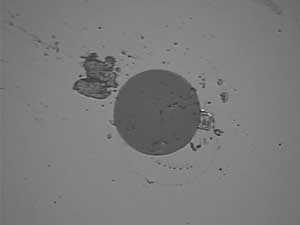
As you can see, the dirt is large compared to the size of the fiber (dark gray), and the core (not visible here) is only 9/125 of the overall diameter of the fiber! More on cleaning. See Product News below for links to vendors of fiber cleaning products.
See news about Fiber Optic Cleaning Videos on YouTube by ITW Chemtronics below.
Measurement Uncertainty: Everyone testing fiber optics should understand that every measurement has some uncertainty - whether you are measuring loss, length, wavelength, power, etc. Knowing that uncertainty is very important to interpreting the measurement. It's worthwhile to read and understand the issue of measurement accuracy covered in this page of the FOA Online Fiber Optic Reference Guide.
Worth Reading or Watching:
What Is The FOA?
Hear FOA President Jim Hayes tell the FOA Story in a 2-part interview by Sound & Video Contractor Contributing Editor Bennett Liles. It tells about the FOA history, goals and achievements.
Part 1: http://svconline.com/podcasts/audio/fiber_optic_association_part1/index.html.
Part 2 http://svconline.com/podcasts/audio/inside-fiber-optic-association2-0924/index.html.
TIA Video Makes Case For Broadband In US
TIA has created a video discussing the status of broadband in the US and the need to catch up with the countries that are way ahead of the US in broadband deployment. The video uses industry reporters and company executives to show the diversity of opinions on how to solve the current problem and what future issues are likely to be. It's actually well done, excepting the reporter to continually refers to fiber as "wire"...
CCCA Whitepaper: Navigating the Pros & Cons of Structured Cabling vs. Top of Rack in the Data Center
A whitepaper from the Communications Cable and Connectivity Association’s (CCCA) newly formed data center committee is a guide for data center professionals and IT managers. The whitepaper, Navigating the Pros & Cons of Structured Cabling vs. Top of Rack in the Data Center, examines the many factors to consider when evaluating top of rack (ToR) and structured cabling configurations. Topics include the impact of those configurations on total management; scalability and upgrades; interoperability; equipment, maintenance and cabling costs; port utilization; power consumption and cooling requirements. Download from CCCA Website
Google Fiber, Aereo and why you’re going to love the gigabit future (4/13)
The gigabit future is going to bring about an Internet that is at least three times faster than anything available today, and that could be good news for innovators everywhere. This goes well beyond being able to stream more movies, download more music and play more games. Technology innovators could fully realize entirely new uses for a faster Internet — ideas that are only in their infancy today, impacting areas ranging from health care and infrastructure to online learning. Washington Post.
What's Up With 100G Ethernet? (4/13)
CNS magazine in Canada's March/April 2013 issue has a good overview article. Read more.
Why a Botched IT Project Will Destroy a Major Corporation in the Near Future (4/13)
The risks associated with major IT projects are being vastly underestimated, according to the largest study of global IT projects ever undertaken. Scary stuff, but good background for IT managers. MIT Technology Review.
"Server Room Spaghetti" (4/13)
Cabling Installation & Maintenance on cabling nightmares. Comic or tragic, depending on your point of view.
Installing Fiber Optics
FOA President Jim Hayes is interviewed by Howard Baldwin for the CISCO BLOG on the issues of installing fiber optic cable and how to "think creatively." Read the blog.
Polishing Fiber Connectors
FOA Director Bill Graham makes the case for epoxy/polish connectors in this article in Cabling Installation & Maintenance Magazine.
How Is Fiber Manufactured?
OFS invites you on a tour of their multimode fiber manufacturing facilities in this new 5-minute video. You will see their highly automated manufacturing operation in Sturbridge, Mass., including their patented MCVD preform fabrication process to fiber draw and final product testing. With a technological heritage dating back to AT&T and Bell Labs, OFS has been manufacturing high-quality multimode fiber since 1981.
Watch the video here.
Where Are The Jobs In Fiber Optics?
The August, 2012 FOA Newsletter presented a review of where we see the most active areas in fiber optics now and where the jobs seem to be most available. You can read this article here. If you are looking for a job, the FOA also has a web page on looking for jobs and a LinkedIn group for CFOTs where jobs can be posted,plus a jobs section in this newsletter.
FTTO: Fiber To The Office
At our seminars in the UAE with eSharp Consultancy, Cliff Walker presented information on his work designing "fiber to the office (FTTO) networks. The concept is based on using fiber to connect large switches in the equipment room to smaller switches with 4 ports at the outlet. You can read Cliff's paper on the airport system to see estimates of the cost savings using FTTO.
Read Cliff Walkers paper on FTTO.
More On Fiber Use In Wind And Solar Power
Craig Bowden, FOA Master Instructor at FiberNexxt in NH, presented a program at the New England Fiberoptic Council recently on fiber in wind power. His presentation is available for downloading here. It's full of good illustrations and photos that tell the story.
Making Sense of The G.657 Standard (OFS)
The G.657 standard was developed by the International Telecommunications Union (ITU) to provide consistency in the evolving requirements for bend-insensitive single-mode fiber.This OFS paper sums up the standard and what it means. Read more.
In Pictures: The World’s Largest Solar Thermal Power Plant
BrightSource’s 370-megawatt facility near Las Vegas is taking shape, with lots of fiber optics being installed by FOA-certified techs..
http://www.technologyreview.com/news/428009/in-pictures-the-worlds-largest-solar-thermal/
Want To Know Where Submarine Fiber Optic Cables Run?
There is a good map online by TeleGeography you can access here.
Choosing the right connector: APC vs. UPC
An interesting article from ADC on the differences in APC and UPC connectors makes the choice easier. Read more.
Confused By Standards?
You are not the only one! As Bob Metcalfe, co-inventor of Ethernet, once said at a conference "The wonderful thing about standards is we have so many to choose from!" But the Siemon Company, an active participant in standards activities for decades, has tried to give some order to this chaos with a new website Standards Informant where they cover the TIA, ISO /IEC and IEEE standards that affect cabling and networks. If you need to keep up with standards, sign up for their email newsletter too.
Patchcords: You Get What You Pay For Says Siemon
Siemon is a global manufacturer of cabling products that has been a big contributor to international standards. Recently they tested patchcords procured from several sources and found out what you might expect - quality suppliers produced quality products but cheap suppliers supplied, well, you can read it here: http://www.siemon.com/go/fiberjumper
Benchmarking Fusion Splicing And Selecting Singlemode Fiber
We've been asked many times "How long does it take to splice a cable?" It's not a simple answer as it varies with the number of fibers in the cable and the work setup, including whether one or two techs are working at a job site. FOA Master Instructor Joe Botha of Triple Play in South Africa did his own analysis based on decades of experience both splicing cables and teaching others how to do it properly. This is one of the best analyses we have seen because Joe includes prep times as well as splicing times and differentiates between one tech and two techs working together. He adds some other tips on fusion splicing too. This should be mandatory reading for every tech and given to every student! Here is Joe's splicing analysis.
Joe also has an excellent writeup on how to choose singlemode fiber that helps understanding the different types of G.6xx fiber. Read it here.
And you will want to read Joe's report on splicing different types of SM fiber, including bend-insensitive (G.657) fiber. Read it here.
Videos on Firestopping: These free videos from UL and the International Firestop Council are good tutorials on firestopping. Go here to view the videos.
Micro-Trenching, Cable Removal
Nano-Trench offers products for micro (or I guess they call it nano-) trenching and their website is very informative. They also have Kabel-X, a method of extracting copper cables from old conduit. Both websites are informative and interesting. Watch this video on the cable removal process!
Free - Mike Holt's Explanation Of The US National Electrical Code (NEC) For Communications Cables
Mike Holt is the acknowledged expert of the US National Electrical Code (NEC). His books and seminars are highly praised for their ability to make a very complicated standard (that is in fact Code - law - in most areas of the US) easily understood. Part of the appeal is Mike's great drawings that make understanding so much easier. Mike makes Chapter 8 of his book available free. It covers communications cables, telephones, LANs, CATV and CCTV, for premises applications. Even if you live in a region or country where the NEC is not the law, you may find this interesting.
Download Mike's Chapter Here.
Fiber Optic Crossword Puzzles For Entertainment And As A CFOT Certification Study Aid (2/12)
Pearson Technologies Inc., a 32-year fiber optic training, technical and marketing consulting firm, announces availability of a free training and certification tool. This tool is a free set of crossword puzzles on the terms of fiber optic installation and products. This set assists those studying fiber optic installation or planning to take the Fiber Optic Association (FOA) Certified Fiber Optic Technician (CFOT) certification examination. The four puzzles are for: light and fiber terms, cable terms, connector and splice terms, optoelectronics and testing terms.
The puzzles can be viewed and printed from: http://www.ptnowire.com/resources.htm or http://www.ptnowire.com/CFOT-Puzzles-vb.pdf. Individuals can receive the answers by email request.
For additional information, contact Pearson Technologies Inc. at: 4671 Hickory Bend Drive, Acworth, GA 30102, at (770) 490-991, or via e-mail at fiberguru@ptnowire.com.
New Eric Pearson Books
A new book from Eric Pearson, Mastering Fiber Optic Network Design, has just been introduced (9/12).

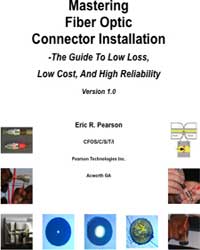
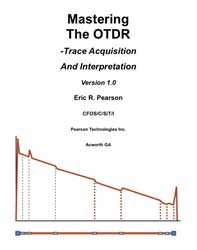
Pearson Technologies Inc. announces the release of four new books, Mastering Fiber Optic Network Design, Professional Fiber Optic Installation, The Essentials For Success, Mastering Fiber Optic Connector Installation and Mastering The OTDR.
Based on 32 years of experience, laboratory testing, development, and training of more than 8000 installers, these books is suitable for training, installation, personnel certification, and reference. Eric's books are perhaps best described as fiber optic "cookbooks," full of detailed directions that reflect many years of tesing in his courses. They are valuable references for the fiber optic tech.
For additional information. contact Pearson Technologies Inc., www.ptnowire.com, fiberguru@ptnowire.com, 770-490-9991
Fiber Optic Cleaning Videos on YouTube
ITW Chemtronics has three fiber optic cleaning videos on  covering Dry Cleaning, Wet-Dry Method, FiberWash and Combination Cleaning. They are good explanations of cleaning processes - the Wet-Dry is especially interesting.
covering Dry Cleaning, Wet-Dry Method, FiberWash and Combination Cleaning. They are good explanations of cleaning processes - the Wet-Dry is especially interesting.
A Documentary Treasure on the History of the Internet
15 minutes of a rarely-seen BBC documentary demolish the myth that ARPAnet was inspired by nuclear war, and explain the far more intriguing truth.
http://www.technologyreview.com/blog/mimssbits/26719/?nlid=4433
Ensuring Distance Accuracy On OTDR Measurements
By JDSU.
Fiber Optic Safety Poster
We've had numerous requests to reprint our guidelines on safety when working with fiber optics, so we have created a "Safety Poster" for you to print and post in your classroom, worksite, etc. We suggest giving a copy to every student and installer.
Corning now offers videos on  . Lots of interesting videos, some technical, some sales, but all good information.
. Lots of interesting videos, some technical, some sales, but all good information.
US Conec's videos on cleaning fibers - show's the results of proper cleaning.
Webinars of Interest

CI&M magazine often does webcasts on interesting topics in premises cabling. FOA President Jim Hayes has done several for them too. Here are the archives of all recent webcasts: http://www.cablinginstall.com/webcasts.html
Broadband Properties Webinar Archives

Lots of interesting webinars, mostly on FTTH. Go here.
Broadcast Engineering Magazine - Fiber Optic Testing
FOA President Jim Hayes presents an overview of fiber optic testing for all applications. Available on Demand. Sign up here.
OSP Magazine Webinars
OSP Magazine (OSP as in outside plant telco) is now offering a number of interesting webinars that cover fiber topics, including network design and specialized components. http://www.ospmag.com/events/web/
Multimode Fiber Characterization Launch Condition Considerations - new ap note from JDSU
JDSU Reference Guide to Fiber Optic Testing – Volume 2 Published
The second volume of the JDSU series on fiber optic testing has been published. Volume 1 focused on Basic Fiber testing and Volume 2 is geared toward fiber optic installers, project managers, telecom technicians and engineers who need to understand fiber networks. Volume 2 also covers Chromatic Dispersion, Polarization Mode Dispersion, Attenuation Profile and Fiber Link and Network Characterization. A 3rd volume, a glossary of fiber optic terms, is also available for download.
This is a "MUST HAVE" for all fiber optic techs. Download your free copies here.
We used this book as one of our references in creating a new page in the FOA Online Reference Guide on chromatic dispersion (CD) and polarization-mode dispersion (PMD).
Careers in Fiber Optics: Brian Smith. A 1998 book on fiber optic jobs is a bit dated, but a free overview is on Google Books and worth a look at it online.
Good Technical Websites
American Polywater (http://www.polywater.com/) has one of the best technical website for cable installers. Here is a rundown on some new material on their site.
Cable Installation using "Push" or "Push/Pull"
Polywater's new Pull-Planner™ 3000 Software allows a "pushing force" variable in pulling tension calculations. Read a White Paper that quantifies the push contribution and compares calculation results to field experience. --
http://www.polywater.com/pushing.pdf
Pulling Cable Through Water?
Read a Product Spotlight on Polywater® + Silicone™, Polywater's new generation underground lubricant. Continued reduction of friction when pulling through water is only one of the unique features of this lubricant. --
http://www.polywater.com/NNNBSL.pdf
Check out their website, especially “Videos,” “Engineer’s Corner” and “Calculators.” http://www.polywater.com/NNNBSL.pdf

" Heard on the Street" is a monthly online newsletter from Frank Bisbee of Communications Planning Corporation that covers the telecommunications and cabling businesses. Each month includes news from manufacturers, trade associations and professional societies like the FOA. You can read the current issue and back issues online.

JDSU has announced the See the Light webinar series, a four-part program designed for anyone involved in the installation, maintenance, and repair of fiber optic systems. It begins with fiber inspection and cleaning and then covers the basics of fiber testing. The webinar series then continues with the more advanced optical time-domain reflectometer (OTDR) and fiber local area network (LAN) testing challenges. More information on the series.
IGI is offering a series of webinars on topics of interest to those in the communications industry. You can join them live ir download from the archives. IGI WEBINAR ARCHIVES UP AND RUNNING - VISIT TELECOMBRIEFINGS.COM TO DOWNLOAD!
IGI, a major market research and technology reporting company (the "Active Optical Cables" below) is offering a a free one year subscription to one of our fiber optics newsletters to FOA members. All they have to do is to send IGI an e-mail stating which newsletter they would like to get. See http://www.igigroup.com/nl.html for a listing of IGI Newsletters.
FOA Tech Topics -
A Fiber Optic Tester In Your Pocket? (See the video on  )
)
Yes! The camera in your cell phone is sensitive to infrared light - lots more than your eye - and can detect light in an optical fiber or from a transmitter. Chris Hillyer,CFOT/CFOS/I, Master Instructor, Northern California Sound & Communication JATC brought this to our attention.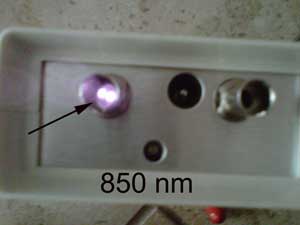

If you have an old cell phone, try it too. Our experience is that older cell phone cameras have better sensitivity at IR wavelengths than newer phones, so you may want to toss that old phone into the toolbox.
How do you design and manufacture fiber optic systems? Choose and install one to serve your communications needs? Troubleshoot problems? The FOA Fiber Optic Technical Bulletins will provide step-by-step guidelines to help you. All are PDF files you can download, print and use.
Testing Update
Are there really 5 different ways to test optical fiber cabling after installation? Why so many? How do the measurements - and more importantly the measurement results - differ? What are the advanteages and disadvantages of each method?
Why are there 4 ways (maybe 5) to test fiber optic cables?
Do OTDRs and OLTS tests give the same results?
New Tech Topics
Industry standards updated to include more international standards
Updated link specs for fiber optic networks - now includes 10/40/100G Ethernet.
Product News
Helping Solve The Patch Cord Problem
Patch panels are often a mess, with cables running in all directions causing - at least after some moves, adds and changes - a big mess. TE Connectivity (AMP to us old-timers) is now offering a new 1.2mm cable design for patchcords that can help reduce the mess.

The 1.2mm patch cord requires half the physical space needed for small form factor 1.6-mm patchcords, one-third of the space needed for commonly-used 2.0-mm patchcords, and is up to 3 times the strength of these larger diameter cables. Available with singlemode SC and LC connectors, the 1.2mm cable enables higher equipment densities in smaller space, while reducing capital and operating expenditures.
Compare the size of the cable to the size of the LC connector above. It's hardly larger than typical 900 micron tight buffer fiber!
One reason this cable is possible is the use of bend-insensitive fiber - reduced bend radius fiber as TEC calls it. We're seeing more BI fiber in premises applications because it allows smaller, more rugged cables that are easier to install.
Bend Insensitive Fibers Get Smaller Coatings, Smaller Cables
OFS has started supplying BI-SMF with a 200 micron coating instead of 250 microns. This means they can make smaller cables or higher density cables, ideal for FTTH and OLANs. Like the TEC cables above, smaller cables are easier to handle, especially in high density environments.
Read more.
Illuminated Fishtape: Why Didn't I Think Of That?
Klein Tools, (http://www.kleintools.com/) for professionals since 1857, introduces a new illuminated fish rod tip (Cat. No. 56119). The bright white, omni-directional light illuminates when fishing above ceilings, in attics, through walls, in crawl spaces and under raised floors. The hook or bullet nose attachments (sold separately) fit smoothly into the threaded top and the ends are tapered for easier pushing and pulling.
Handheld OTDR
Advanced Fiber Solutions has introduced a new compact portable OTDR that offers high resolution (to 1m) and light weight (1.6 pounds, 0.72 kg) plus numerous wavelength and range options. Here is more information.
Micro-Trenching, Cable Removal
Nano-Trench offers products for micro (or I guess they call it nano-) trenching and their website is very informative. They also have Kabel-X, a method of extracting copper cables from old conduit. Both websites are informative and interesting. Watch this video on the cable removal process!
Protecting Pedestals From Rodents
Pedestals and underground vaults can be damaged by rodents who come up through the base and damage cables. Uraseal "Drain N'Seal" foam deters mice from taking up residence in your pedestals. They have some good videos on using their product.
Used Test Equipment – Buy or Sell
http://www.testequipmentconnection.com/
Have you read the FOA Tech Topics on Cleaning?
More links on cleaning:
As much as 70% of the problems associated with deploying fiber to the home result from something as simple as dirty connectors according to JDSU. Telephony Online.
US Conec's videos on cleaning fibers - show's the results of proper cleaning.
Cleantex Alco Pads
FTTH Notes:
FTTH in MDUs (Multiple Dwelling Units)
When we talk about FTTH, we often assume we are installing the fiber to a “home” where it terminates in a optical line terminal (OLT) and services (voice, data and video) are delivered inside the subscriber’s "home." But since we may have detached single-family homes, row houses or living units in a large building, the situations can be quite different, requiring different architectures and installation practices. To clarify the options for fiber in MDUs, FOA has created a new page in our FTTx section of the FOA Guide to explain the options.

FOA Guide: FTTH in MDUs
Google Map Shows Worldwide FTTx Projects
One of the better sites to track FTTx projects is this Google maps application that shows projects on a world map with details on the project.
Click on the map above or here to view the interactive web map.
Testing FTTH
JDSU shows how to test a PON with an OTDR: http://www.jdsu.com/other-literature/PON-OTDR_fop_an_ae.pdf
Want To Learn More About FTTx?
The FOA has created a special FTTx resources section of our website with a FTTx links page with lots of links to news, market reports, technical articles and vendor technical and product information. Here is a great place to start learning more about FTTx.
FOA's CFxT FTTx Certification Program Explained
Read the Broadband Properties article about the FOA FTTx certification program. Read the article about FOA President Jim Hayes being honored for his work promoting FTTH.
---
Employment
Where Are The Jobs In Fiber Optics?
The August, 2012 FOA Newsletter presented a review of where we see the most active areas in fiber optics now and where the jobs seem to be most available. You can read this article here. If you are looking for a job, the FOA also has a web page on looking for jobs and a LinkedIn group for CFOTs where jobs can be posted,plus a jobs section in this newsletter.
FOA Jobs Website
We get many questions from CFOTs, students at FOA-Approved schools and others contemplating getting into the fiber optic business regarding jobs in fiber optics - and how to find them - so we’ve created a new web page to share some information we've gathered about jobs in our industry. The information is designed to help you understand what jobs are available in fiber optics, how to find them and apply for them.
While the overall economy is pretty bad - you've probably heard that there are 5 times as many people unemployed in the US as there are jobs available, telecom is a bright spot - broadband is a major focus of stimulus spending in the US and countries around the world are building fiber networks as fast as possible. Even wireless companies have to build fiber for their backhaul. Cities are installing fiber linked surveillance cameras and smart traffic lights. Fiber is the link making Smart Grid possible. Companies like Allied Fiber are building large private networks. Telecom is one of the fastest growing businesses worldwide.
If you are looking for a job in fiber optics, here is the FOA's guide to jobs.
The FOA has created a group on  expressly to help our CFOTs find employment and contracting opportunities. If you are a CFOT and are interested in participating, join us on
expressly to help our CFOTs find employment and contracting opportunities. If you are a CFOT and are interested in participating, join us on  . If you have job openings, let us post them on
. If you have job openings, let us post them on  .
.
A list of 10 ways to get your resume noticed, from Marketplace on NPR
Job Openings
Cable Techs - San Francisco Bay Area (6/13)
Field Service Technicians with experience in telecommunications, CAT5/CAT6 cabling, T-1 Circuits, POS installation/break/fix, structured cabling, as well as extensive knowledge of the 25 pair color code in the Bay Area.
Contact:
Rebekah Bedell
rbedell@spencertech.com
508-635-2068
Electro-Optic (EO) Specialist (6/13)
*******************************************************
This position requires candidates to be eligible for Security Clearance.
US Citizenship Required.
*******************************************************
Summary: Our client develops and tests prototype optical communications systems over free-space channels. A major group initiative is the development of low size, weight, and power (SWaP) terminals that can be integrated onto aircraft and at ground locations to support high data-rate communications over fading links, and include identifying and validating techniques for mitigating signal power fluctuation due to atmospheric turbulence. Group capabilities include high-fidelity atmospheric modeling and simulation, and the development of multi-Gb/s modems; pointing, acquisition, and tracking
systems; high-speed electronic coding and interleaving schemes; and network-standard interfaces. The group works with government and industrial partners to help expedite the transfer of capability to operational systems.
Description: Optical fiber splicing and re-coating, including equipment set-up and maintenance, and proof-testing of fiber splices; development of splicing recipes for specialty fibers; documentation of splicing protocols and testing results. Basic optical performance characterization of electro-optic components, including measurement of insertion loss, polarization, power, optical spectrum. Ability to work as a member of a high-performing team in support of a rapidly-paced, priority program.
Requirements:
· Graduation from a two-year day technical school or its equivalent and a minimum of two years of applicable experience is required.
· Prior experience with optical fiber splicing, re-coating and proof testing and familiarity with supporting technologies are required.
· The candidate must have a working understanding of basic optical characterization equipment.
· The candidate must be well organized, detail oriented, exhibit good manual dexterity and be able to work on more than one task simultaneously.
· U.S. Citizenship is Required.
· Ability to obtain and maintain a Security Clearance is Required.
***Minuteman Group, LLC is an equal opportunity employer***
Any candidate interested in this position should send their resume in word format to the e-mail address below.
Thank You for your time.
Stephanie McNulty
Tel: 781-861-7493
Fax: 781-863-8810
stephanie@minuteman-group.com
Instructor: T1/ T3 Test and Turn-up Instructor Needed (5/13)
A national training company has a need for a dynamic, energetic, and self-sufficient classroom instructor. We have a need for an instructor to deliver a 24 hour telecom T1 / T3 Test and Turn Up hands on lab course in Northern CA.
We need a person with a working knowledge of T1 / T3 test and turn up and capable of sharing their expertise with others and developing hands on lab exercises and working with in class lab equipment.
- Position is a 1099 part time contractor position.
- Course will be scheduled during regular business hours, Monday – Friday
- We reimburse travel expenses Successful candidates will be required to:
- Determine course content and student learning objectives; determine methodology, prepare course syllabi, lesson plans, and student manuals as needed
- Maintain accurate class records
- Work with a company representative and possibly the onsite reps to coordinate and roll out programs in an organized and efficient manner
Minimum requirement:
- 2 years of teaching/instructional experience helpful
- Excellent verbal skills
- Excellent customer service skills
- Ability to be self-sufficient and not reliant on direct supervision
- Installer experience with T1 / T3 Test and Turn Up
- Salary commensurate with experience
- Please, only qualified instructors need apply
- Please include resume when responding to this posting Please send your resumes and contact info to the FOA at info@thefoa.org for forwarding to the school.
OSP Planners, Field Engineers or Design Engineers (5/13)
If anyone knows of any OSP Planners, Field Engineers or Design Engineers, contact KCarbone@jobs-staff.com. I have a lot of positions available nationwide.
Senior Director, Sales - High-Reliability Optoelectronics Solutions: (5/13)
The ideal Sr. Director Sales, High-Reliability Optoelectronics Solutions candidate possesses +8 years of business experience and a proven track record of supporting a growing business in progressively more challenging roles ideally at companies +$25M in revenue. This experience includes +4 years of successful related optoelectronic or electronic industry solutions sales management background in senior sales management roles in emerging growth technology companies with positive industry relationships and contacts. Preferred employer industry domain sales experience in order of preference: optoelectronic components & assemblies; high-speed electronic components & assemblies; high-performance photodiodes, detectors and assembly solutions experience is a plus. Candidate ideally possesses a wide array of customer industry domain market experience to include: Medical, Commercial, Test & Instrumentation, Mil/Aero, Federal (e.g., FAA, FDA, Homeland Security). Candidate is experienced in selling solutions, not just equipment or components from a line-card, candidate possesses strong experience in managing direct sales, indirect sales channels, and strategic partner relationships, as well as consultative selling of technology solutions.
Executive Advantage Group, Inc. has recently been exclusively retained again by our client Advanced Photonix, Inc. (NYSE, Amex: API) to conduct a new Senior Director, Sales - High-Reliability Optoelectronics Solutions search.
We've showcased this new retained executive search in the following search specific website: http://executive-advantage.com/API_SDS
On the search specific website's - The Position Profile - page there is a link to - download the Detailed Position Spec.
If you are aware of a stellar candidate that would excel in this role based on the individual brief position descriptions below please have them send their resume to me, Michael A. Rothstein, Managing Principal, Executive Advantage Group, Inc.
Email: mrothstein@executive-advantage.com, Direct: 503-372-9084
R&D Scientist (5/13)
I am currently networking a position with Honeywell Aerospace for an R&D Scientist III within the community it appears you have some authority. Please consider taking a look at the opportunity within the link provided and feel free to connect me or pass the information along to anyone in your network you feel might qualify and have interest. http://www.careersathoneywell.com/en/JobSearch/JobDescription.aspx?LanguageID=1&jobid=00214706
Chad Meacham
Senior Recruiter
Honeywell Aerospace - Engineering & Technology
Randstad Sourceright, Honeywell's Staffing Partner
TEL: 319.471.0992
Chad.Meacham@Honeywell.com
www.careersathoneywell.com
Staffing Resource Center
Honeywell Aerospace Overview Video: http://www.youtube.com/watch?feature=player_embedded&v=F7UBlqQfex0#!
Optical Engineer (5/13)
My client is also seeking to immediately fill a Senior Scientist/Engineer position in the area of Applied Optics, Optoelectronics and/or Electroptical Devices for Data and Telecommmunication industries, or someone with extensive experience in Optical Devices for these applications. The ideal candidate will have a proven track record in one or more of the following areas: Applied Optical or Electrooptical device & component development, Optical modeling and simulation, Optical physics or Non-linear optics. Additional experience in fiber optic/electronic interface modules, devices & applications, data-rate characterization and/or relevant package integration will be a definite plus.
Educational background should include a PhD in Optical Science, Optoelectronics, Optical or Electrical Engineering or a related discipline, and five years or more in the field of applied optical device technology or application development. Masters degree in Optical/Electrical Engineering with 10 years of experience is equally suitable.
The candidate will be part of a multidisciplinary team of chemists, material scientists, optical scientists, application and process engineers to develop and deliver suitable technology platforms that provide optoelectronic connectivity solutions the client. In this role, the candidate will be instrumental in developing devices, integration technologies and packaging schemes to extend modern high speed data-rate electroptic products. The candidate will also be responsible for developing customer relationships with leading edge technology companies to nurture new opportunities and an innovative product pipeline for the organization.
The candidate will be part of a global staff. The position is located in Menlo Park, California.
Other Skills and Desirable Traits:
The candidate must be a dynamic, self-starting individual with a strong bias for action and impact.
A demonstrable track record of applied creative thinking and innovative skills.
Strong people and technology leadership skills are essential to accelerate development efforts toward achieving state-of-the-art technology targets.
Working with Internal Business units and external customers will be a critical component of this position, to construct customer-based directives that drive optical connectivity solutions forward in data & telecommunication industries.
The candidate should have strong networking skills (local to global) and they will participate (in different roles) in strategy development, technology assessments and technical project & portfolio management.
Contact:
Nicholas Meyler
GM/President, Technology
Wingate Dunross Associates, Inc.
ph (818)597-3200 ext. 211
nickm@wdsearch.com Google Hiring in KC: MDU Field Manager, Google Fiber - Kansas City (4/13)
Seeking a contract MDU Field Manager to join the Google Fiber rollout team in Kansas City. 10 years of experience with fiber network deployments, including experience with constructing new outside and inside plant fiber infrastructure, and 5 years of experience with MDU infrastructure. Posted on LinkedIn until April 30.
Optical Engineers: Client has 2 openings (4/13)
Optical Engineer 1
In this position you will be responsible of designing, modeling, analyzing, and testing optical and electro-optical systems and components.
Qualifications:
- BS in Optical Engineering or Physics
- 2+ years in a technical field
- Experience in assembly and testing of design
- Top Secret Clearance a Plus
Optical Engineer 2
In this position you will be responsible for development of laboratory prototypes, evaluation of their feasibility, the identification of their performance limitations, and the resolution of their technical risks.
Qualifications:
- PhD in Optics, Physics, or Electrical Engineering
- Process skills required to design, model, analyze, and test optical and electro-optical systems and components, including sensors, lasers, fiber-optics, and photonics components.
- Hands-on experience with optical test and measurement equipment
This position is based out of Hartford, CT area; salary range is totally based on your background, salary history and the interview process. Relocation will be provided to the right candidate. This is a direct hire full-time position with great benefits and looking to hire immediately. It looks like you may be a great fit for this opportunity, if not you may know someone.
If you are interested in this opportunity, please send me your resume in MS Word I will contact you to schedule a time to discuss this opportunity in detail if you qualify.
Christine Korzenko
Account Manager |Monroe Staffing
